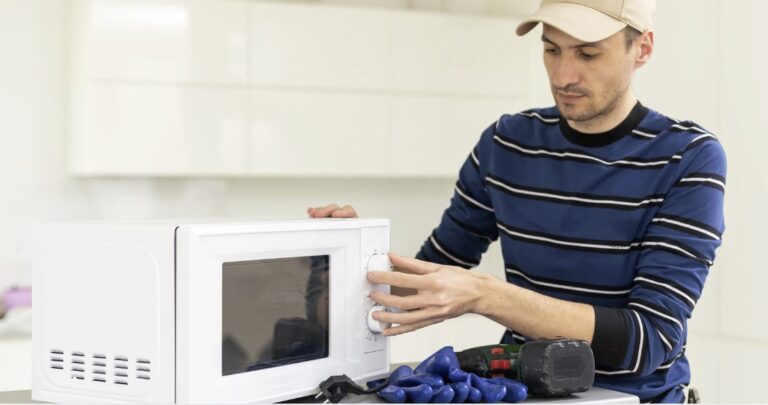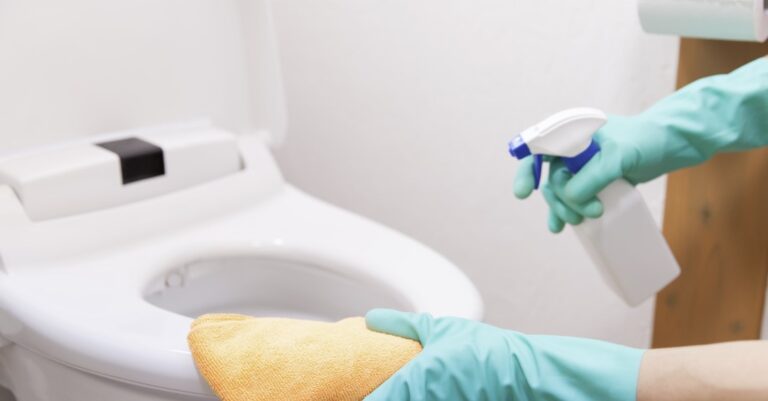12 Possible Causes of a Samsung Dryer Not Heating and Solutions
Samsung dryers are known for their quality and innovation. Samsung dryers offer efficient, convenient drying with cutting-edge technologies. Dryers are essential in modern households, but they sometimes break. Even high-end Samsung dryers have bugs. Samsung dryers sometimes have heating issues that leave you with damp laundry. Failures in thermal fuses, connections, and thermostats can cause this collapse. Despite its warranty, the heating element’s failure is the leading cause. A faulty part could be to blame if your Samsung dryer is not heating. This article explains all possible reasons for a Samsung dryer not heating and their solutions.
Is your Samsung Dryer Not Heating?
A faulty part could be to blame if a Samsung dryer stops producing heat. Fused fuses and blocked air vent conduits are common problems. Should the problem persist after vent pipe cleaning, the defective component can be found and replaced. To assess ingredient effectiveness, you can utilize a multifunctional meter. When your dryer has this problem, you must learn about the solutions. Instead of calling a technician, try these initial actions.
Read More about Samsung:
- Samsung Washer UR Code
- Samsung Washer Code U6 Errors
- 5 Common Samsung Dryer Problems
- Samsung Washer SC Error Code
- Samsung Air Conditioner Error Codes
- Speed Queen Dryer Not Heating
Reasons why Samsung Dryer is not Heating and their Solutions
The following are the causes of a Samsung dryer not drying:
1. Burned Thermal Cut-Off Fuse
Thermal cut-off fuses are essential safety components in appliances like stoves and Samsung dryers. Manufacturers design them as sacrificial devices to protect the machine from overheating by causing them to burn out or explode when necessary. Samsung dryer heater elements incorporate thermal cut-off fuses to prevent overheating. When these fuses melt, they halt the dryer’s heating process. Excessive dryer temperatures can lead to fuse melting. Overheating in dryers is frequently linked to ventilation problems. Inadequate ventilation causes the heater assembly to overheat, subsequently triggering the thermal cut-off fuse to burn out.
Troubleshooting Steps:
Replace the Burned Thermal Cut-Off Fuse
- You must replace these components as they are not repairable. Ensure the power supply is disconnected before commencing any repairs.
- Refer to your user manual and technical documents for guidance.
Access the Heater Component
Disassemble the dryer panels, typically the back panel, to access the heater component. The user handbook can provide valuable insights.
Allow the heater assembly to cool down before attempting any repairs.
Remove the damaged fuse before proceeding to install the new one.
Address the Underlying Cause
While replacing the fuse resolves the immediate issue, addressing the root cause is essential. Regularly clean the dryer vents to ensure unimpeded airflow.
Safety Precautions
Schedule routine dryer vent maintenance to prevent overheating issues. Maintaining proper airflow reduces the likelihood of thermal cut-off fuse problems and ensures your Samsung dryer continues to operate efficiently.
2. Inspecting Gas Valve Solenoid and Igniter
Gas valve solenoid and igniter are critical components in gas-powered dryers, such as Samsung models. Gas valve solenoid coils regulate gas flow to the burner assembly, while the igniter is responsible for lighting the dryer gas. Any malfunction in these components can decrease the dryer’s heating performance.
Troubleshooting Steps:
Testing the Igniter
- Check if the gas ignites when the igniter is activated or if it ceases to function.
- If the igniter fails to light, check for continuity by testing both ends of the igniter. Continuity should exist.
- If there’s no continuity, replace the igniter.
Addressing Igniter-Gas Valve Solenoid Interaction
- If the igniter glows but fails to ignite the gas, replace the gas valve solenoid coils.
- If previous replacements haven’t resolved the issue, consider replacing the gas valve solenoid coils and the igniter to address the problem comprehensively.
Preventing Overheating
To prevent overheating issues in the future, regularly clean the dryer vents. This proactive maintenance measure ensures unobstructed airflow and enhances the overall efficiency of your Samsung dryer.
Safety Precautions
- Wait to touch the heater assembly until it has cooled to room temperature.
- Remove the malfunctioning fuse before installing the new part.
- Replacing the fuse resolves the immediate problem but does not address the root cause.
3. Addressing Flame Sensor Issue
In gas dryers, a malfunctioning flame sensor can result in a loss of heat. The flame sensor’s primary role is to monitor the flame’s temperature, and when it malfunctions, your dryer’s ability to generate heat is compromised.
Troubleshooting Steps:
Disconnect the Dryer
Unplug the dryer from its power source to ensure safety during the troubleshooting and repair.
Access the Flame Sensor
To reach the flame sensor, remove the top and side panels of the dryer. This step is crucial for gaining access to the sensor for testing or replacement.
Continuity Test
- Utilize a multimeter to perform a continuity test on the flame sensor.
- Test the sensor’s continuity at room temperature to assess its functionality.
Confirm Continuity
Check the multimeter reading to confirm continuity in the flame sensor.
Continuity indicates that the flame sensor is operating as intended.
Safety Precautions
To restore proper heating in your dryer, you need to replace the flame sensor, which is malfunctioning and causing a lack of continuity.
4. A Defective Heating Element
The Samsung dryer’s heating element is crucial in effectively drying clothes. While the heating element design may vary slightly between different Samsung dryer models, their fundamental function is to produce heat for drying.
Troubleshooting Steps:
Power Supply
Power is directed to the heating element whenever the dryer requires heat. This heat generated is then circulated within the dryer with the assistance of a blower fan, ensuring thorough drying.
Symptoms of a Faulty Heating Element
When your Samsung dryer ceases to provide heat, a common culprit is a burnt-out heating element. Two diagnostic methods can confirm this issue:
Multimeter Test
Utilize a multimeter to measure the resistance of the heating element. A functioning heating element typically registers a resistance of approximately 10 Ohms, confirming its operational status.
Visual Inspection
Alternatively, visually examine the heating element using a flashlight. A burnt-out element may emit a distinctive odor or exhibit visible burn marks along its length.
Replacement
To restore heat, replace the faulty heating element in the dryer. This repair is generally manageable, though it may require time and effort due to the challenge of accessing the heating element’s housing.
Safety Precautions
Before undertaking any dryer repairs, always disconnect the power supply from the appliance. This precaution is essential to eliminate the risk of electric shock and ensure a safe working environment during the repair process.
5. A Clogged Lint Filter
The lint filter in your Samsung dryer serves a crucial purpose. It captures lint, fibers, and debris from your clothes during drying. A clogged lint filter can hinder airflow, leading to heating problems.
Troubleshooting Steps:
Check the Lint Filter
- If your Samsung dryer is not generating heat, inspect the lint filter.
- The lint filter is typically located beneath the machine or on the front panel adjacent to the exhaust pipe exit.
Clean the Lint Filter Regularly
- It is essential to routinely clean the lint trap after each laundry cycle to maintain optimal dryer performance.
- Remove the lint filter from its housing and use a vacuum cleaner or a brush and scraper to eliminate any accumulated lint or dust.
Reassemble and Test
- After cleaning the lint filter, reinsert it into its original position.
- Run a test cycle to determine whether the cleaning resolved the heating issue.
Safety Precautions
Maintaining a clean lint filter is essential to ensure proper airflow and prevent heating problems in your Samsung dryer. We recommend cleaning the lint filter after each cycle to keep the appliance’s efficiency.
6. A High-Limit Thermostat Issue in Your Dryer
The high-limit thermostat in your dryer plays a critical role in monitoring the appliance’s temperature. It is a safety mechanism, automatically turning off the dryer if the burner approaches a dangerously high temperature to prevent overheating.
Troubleshooting Steps:
Check for Incorrect Functioning
If your dryer shuts off even when the internal temperature is significantly lower than the overheating limit, it indicates a potential malfunction of the high-limit thermostat.
Examine the surrounding components.
Since high-limit thermostats do not commonly fail, it’s advisable to inspect the adjacent components to determine if they are functioning correctly.
Multimeter Test for Continuity
- To pinpoint the issue, conduct a diagnostics test using a multimeter to check for the continuity of the high-limit thermostat.
- If the thermostat maintains continuity when it should not, it indicates a malfunction, and replacement is necessary to ensure proper dryer operation.
7. A Blocked Air Vent Line
Blockages in the air vents can hinder proper heating in your dryer. The vent system is critical for airflow, and any obstruction can lead to heating problems.
Troubleshooting Steps:
Check for Airflow Obstructions
- If your dryer’s heating is compromised, consider the possibility of a clogged air vent.
- The dryer drum may become heated but not effectively dry clothes due to blocked ducts.
Unplug and Inspect the Air Vent
- Disconnect the air vent from the dryer and inspect it for debris or blockages.
- Clean the vent thoroughly and ensure it is free of any obstructions before reinstalling it.
Regular Lint Filter Cleaning
- To prevent blockages in the air vent, establish a routine of cleaning the lint filter frequently.
- Regular maintenance of the lint filter helps maintain proper airflow, reducing the risk of air vent blockages.
8. Lack of Gas
A gas dryer failing to heat up could be due to a lack of gas supply, which is easily verifiable.
Troubleshooting Steps:
Check the Gas Valve
Ensure you turn on the gas valve and fully open it to allow gas flow.
Inspect the Pipe Connection.
Verify that the gas pipe is securely and correctly attached to the dryer. Loose or improperly connected gas pipes can impede gas flow to the dryer.
Verify Gas Bill Payment
Ensure that you have paid your gas bill. A disrupted gas supply due to unpaid invoices can cause your gas dryer to stop heating.
Safety Precautions
If all the above steps are in order, and the gas supply issue persists, consider consulting a professional technician to diagnose and rectify the problem.
9. A Failed Cycling Thermostat
The cycling thermostat is vital in regulating the dryer’s temperature by cycling the heater on and off as needed. If this thermostat malfunctions, it can result in a lack of heat in the dryer.
Troubleshooting Steps:
Verify Other Components
Inspect other commonly malfunctioning components before replacing the cycling thermostat to rule out other potential issues.
Multimeter Test for Continuity
- To determine the functionality of the cycling thermostat, perform a continuity test using a multimeter.
- Lack of continuity in the thermostat indicates a malfunction and necessitates replacement to restore proper heating in the dryer.
10. A Faulty Timer
If your dryer is not heating, a potential issue might be a malfunctioning timer. However, it’s relatively rare for the timer to cause this problem.
Troubleshooting Steps:
Inspect Other Components First
Before considering a timer replacement, examine more common points of failure to eliminate other potential causes of the heating issue.
Multimeter Test with Wiring Diagram
- If all other components function correctly, you can test the timer using a multimeter and refer to the dryer’s wiring diagram.
- Promptly replace a damaged or malfunctioning timer during testing to ensure proper dryer operation.
11. A Failed Control Board
The control board in your dryer acts as the device’s “brain,” when it malfunctions, it can be challenging to test directly. However, inspecting other susceptible components is essential before exploring control board issues.
Troubleshooting Steps:
Look for Signs of Damage
- Inspect the control board and surrounding area for damage, such as burnt wires or tripped circuits.
- If components on the control board are not functioning correctly, it may indicate a potential issue with the control board.
Control Board and Heater Relay
The control board houses numerous electrical components, and a failure in this board can lead to heater relay problems, resulting in a lack of power to generate heat.
Steps for DIY Control Board Replacement
If you choose to replace the control board yourself, here are some steps to follow:
- Locate the primary control board behind the panel that controls the dryer’s settings.
- Remove the cover to access the control board. The specific placement of components may vary by model, so consult the handbook for precise instructions.
- Disassemble the control board by disconnecting the associated cables and screws.
- When installing the new control board, make sure to reinstall the screws and plugs in the same manner as before.
Professional Technician Assistance
Suppose you encounter difficulties during the control board replacement process or need clarification on the diagnosis. In that case, it’s advisable to seek assistance from a professional technician to ensure a correct and safe repair.
12. A Faulty Drive Motor
In many dryer drive motors, the centrifugal switch plays a crucial role. It engages the heat cycle contact upon motor startup, enabling the dryer’s heat source to function. When this switch malfunctions, the dryer may not heat up even if the motor is running.
Troubleshooting Steps:
Examine Centrifugal Switch
- If your dryer fails to heat and the motor is running, consider the possibility of a malfunctioning centrifugal switch on the motor.
- If the centrifugal switch fails, you must replace the entire motor because buying the button separately is impossible.
Replacement Consideration
If you suspect a defective centrifugal switch, contact a technician or the manufacturer to inquire about replacement options and determine if replacing the motor is necessary to ensure proper dryer heating.
Samsung Dryer Not Heating Due to Poor Maintenance Issue
A typical problem homeowners face is a Samsung dryer not heating up, often attributed to poor maintenance practices. Neglecting to clean the lint filter and exhaust duct regularly can lead to reduced airflow, causing the heating element to overheat and malfunction. To ensure efficient operation and prevent heating issues, it’s crucial to prioritize regular maintenance of your Samsung dryer.
1. Inspect and Clean the Dryer Cabinet
Begin by opening the dryer cabinet to assess its cleanliness. A dirty dryer cabinet can lead to various operational problems, making cleaning an essential troubleshooting step.
2. Importance of Cleaning
Regular dryer cleaning is crucial as it helps maintain efficiency and prevents potential issues. Cleaning should not be considered a time-wasting activity.
3. Expanded Troubleshooting Area
Cleaning the dryer cabinet ensures better maintenance and provides a larger troubleshooting area, making identifying and addressing potential problems more manageable.
4. Focus on Airflow
Adequate airflow is essential for proper dryer operation. Clogged exhaust ducts are a common culprit behind reduced airflow, which can ultimately lead to the heating system shutting down entirely.
5. Addressing Clogged Ducts
If you suspect clogged exhaust ducts, cleaning them to restore proper airflow and prevent heating system issues is essential. Regular maintenance of exhaust ducts is critical to dryer performance.
6. Procedure for Resetting a Samsung Dryer
To reset a Samsung dryer, follow these steps:
- Disconnect the Dryer
To ensure safety and avoid electric shock, unplugging the dryer from the power source is essential.
- Wait for Electrical Discharge
Wait at least five minutes to allow any residual electricity to discharge from the cables.
- Plug In the Dryer
After waiting, plug the dryer back into the power source.
- Press Start/Pause Button
Press and hold the Start/Pause button using the remote control.
- Hold for 15 Seconds
Keep your finger on the Start/Pause button for at least 15 seconds.
- Check for Reset
If the Samsung dryer restarts without displaying an error code, you have successfully reset it.
Common Parts to Check and Fix for a Samsung Dryer Not Drying
When troubleshooting a dryer that won’t heat, consider these common parts:
1. Vent
The dryer vent can become clogged or blocked, hindering proper airflow and heating. Cleaning or repairing the vent is crucial for efficient drying.
2. Thermostat
The thermostat, responsible for regulating temperature, can malfunction due to overheating, short circuits, or mechanical issues. A faulty thermostat can lead to heating problems in the dryer.
3. Drum
Numerous factors, such as the heating element, can harm the drum’s internal components. Overheating, short-circuiting, and mechanical forces may contribute to drum-related issues that result in the dryer not heating properly.
Read More about
Conclusion
Having a functional dryer is essential in every household, and when it encounters problems, it can be inconvenient. Fortunately, this article provides straightforward solutions for a Samsung dryer not heating. As mentioned earlier, if specific components malfunction, your Samsung dryer might cease to work correctly. However, you can often resolve minor problems, such as a blown fuse or a faulty heating element. Ensure any replacement parts you purchase are compatible with your specific dryer model. To ensure a successful repair, consider these steps:
First, opt for genuine spare parts from Samsung, as not all third-party alternatives are reliable.
Second, double-check your dryer model to ensure you select the correct replacement part.
Third, consult your dryer’s handbook, particularly if it has complex systems, to guide you through the replacement process without causing damage to other components.
Finally, if these steps lead to a resolution or you need clarification on the repair process, feel free to seek professional assistance for a thorough diagnosis and fix.
Frequently Asked Questions
Why Is My Samsung Dryer Running But Not Heating?
There could be several reasons for this issue. The most common causes include:
A faulty heating element.
A blown thermal fuse.
A malfunctioning thermostat.
A clogged dryer vent.
To pinpoint the exact problem, you should troubleshoot and replace or repair the affected components.
How Do I Reset The Heater on My Samsung Dryer?
To reset the heater on your Samsung dryer, follow these steps:
1. Turn off and unplug the dryer from the power source.
2. Wait for at least five minutes to allow any residual electrical charge to dissipate.
3. Plug the dryer back in and turn it on.
4. If applicable, select the desired heat setting.
5. Start the dryer and monitor if it heats up properly.
How Do I Test My Dryer Heating Element?
To test your dryer’s heating element, follow these steps:
1. To ensure safety, it is essential to disconnect the dryer from its power source.
2. Locate the heating element, usually found at the back of the dryer.
3. Use a multimeter set to the resistance (Ohms) setting.
4. Touch one multimeter probe to each terminal of the heating element.
5. A functional heating element should show a resistance reading. If it reads as an open circuit or has no continuity, the element is likely faulty and needs replacement.
How Do You Fix A Dryer Heating Element?
To fix a faulty dryer heating element, follow these steps:
1. To ensure safety, it is essential to disconnect the dryer from its power source. Please do so before performing any maintenance or repairs on the appliance.
2. Access the heating element, typically located at the back of the dryer.
3. Remove any mounting screws or components obstructing access to the heating element.
4. Remove the attached wires to disconnect the heating element terminals.
5. Replace the old heating element with a new, compatible one.
6. Reconnect the wires to the new element, ensuring they are secure.
7. Reassemble any components you removed.
8. Plug in the dryer and test it to ensure it’s heating correctly.
How Do You Reset A Dryer That Won’t Heat?
A: To reset a dryer that won’t heat, follow these steps:
1. Turn off and unplug the dryer from the power source.
2. Wait for at least five minutes to allow any residual electrical charge to dissipate.
3. Plug the dryer back in and turn it on.
4. If applicable, select the desired heat setting.
5. Start the dryer and monitor if it heats up properly.
6. If the issue persists, refer to the specific troubleshooting steps related to your dryer model or seek professional assistance.





